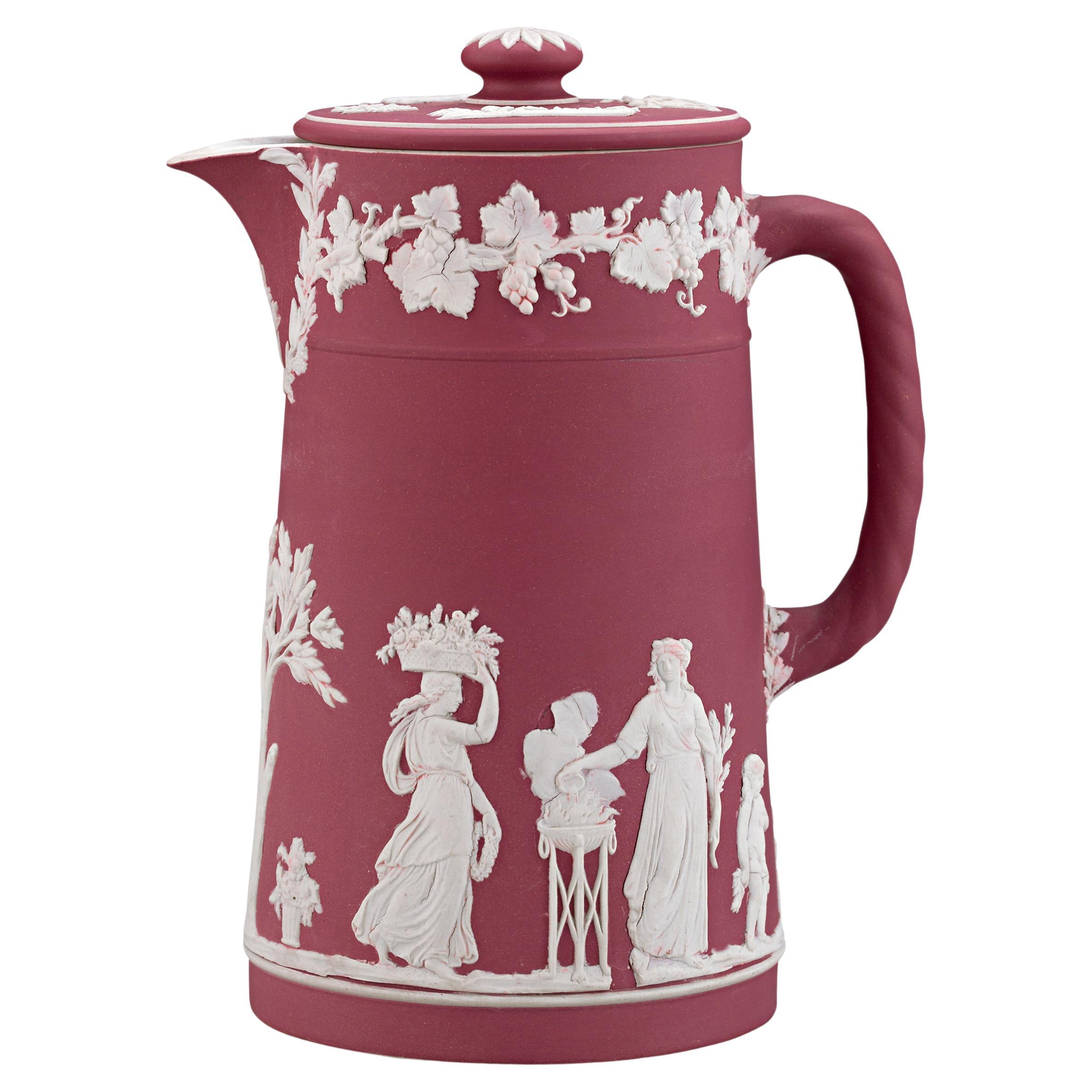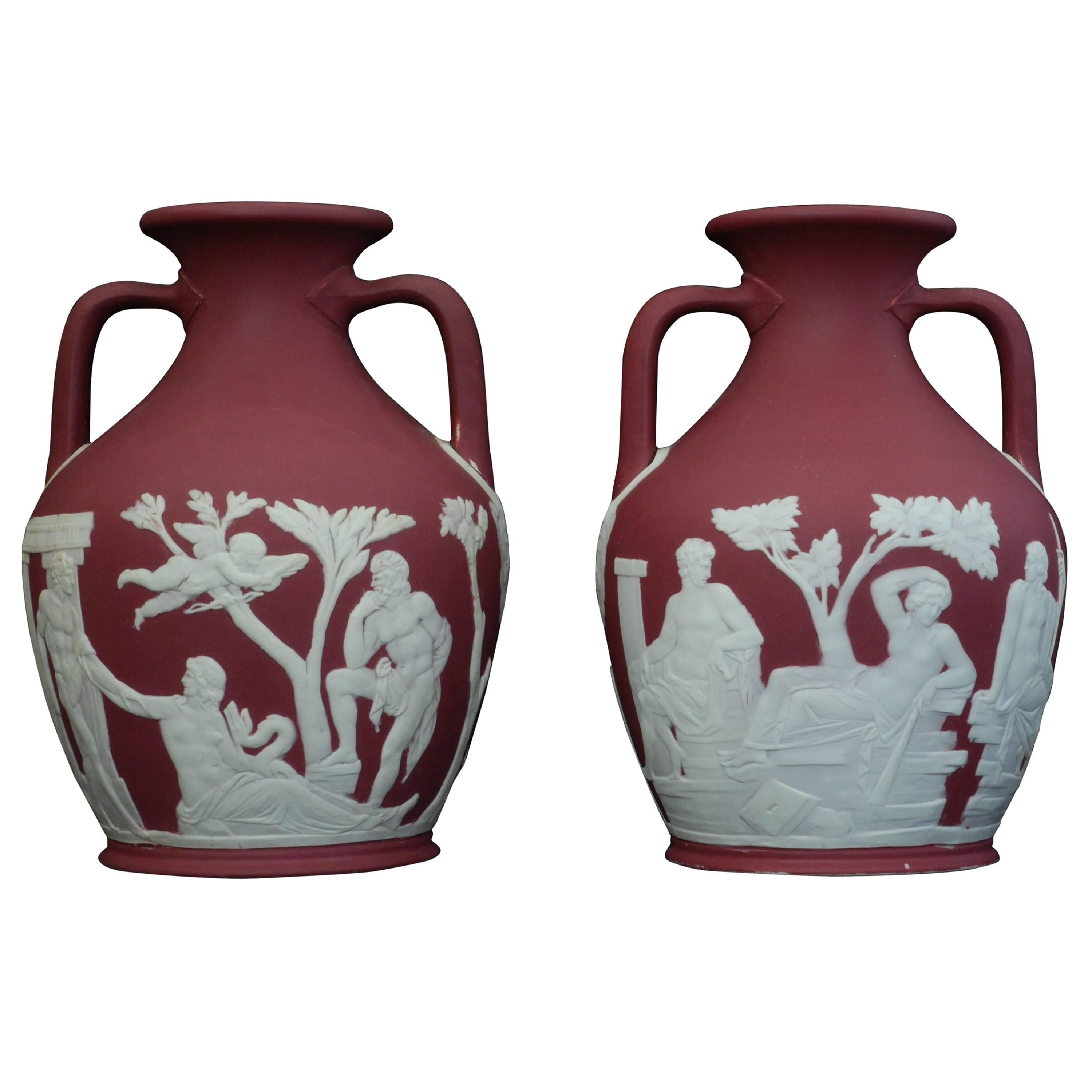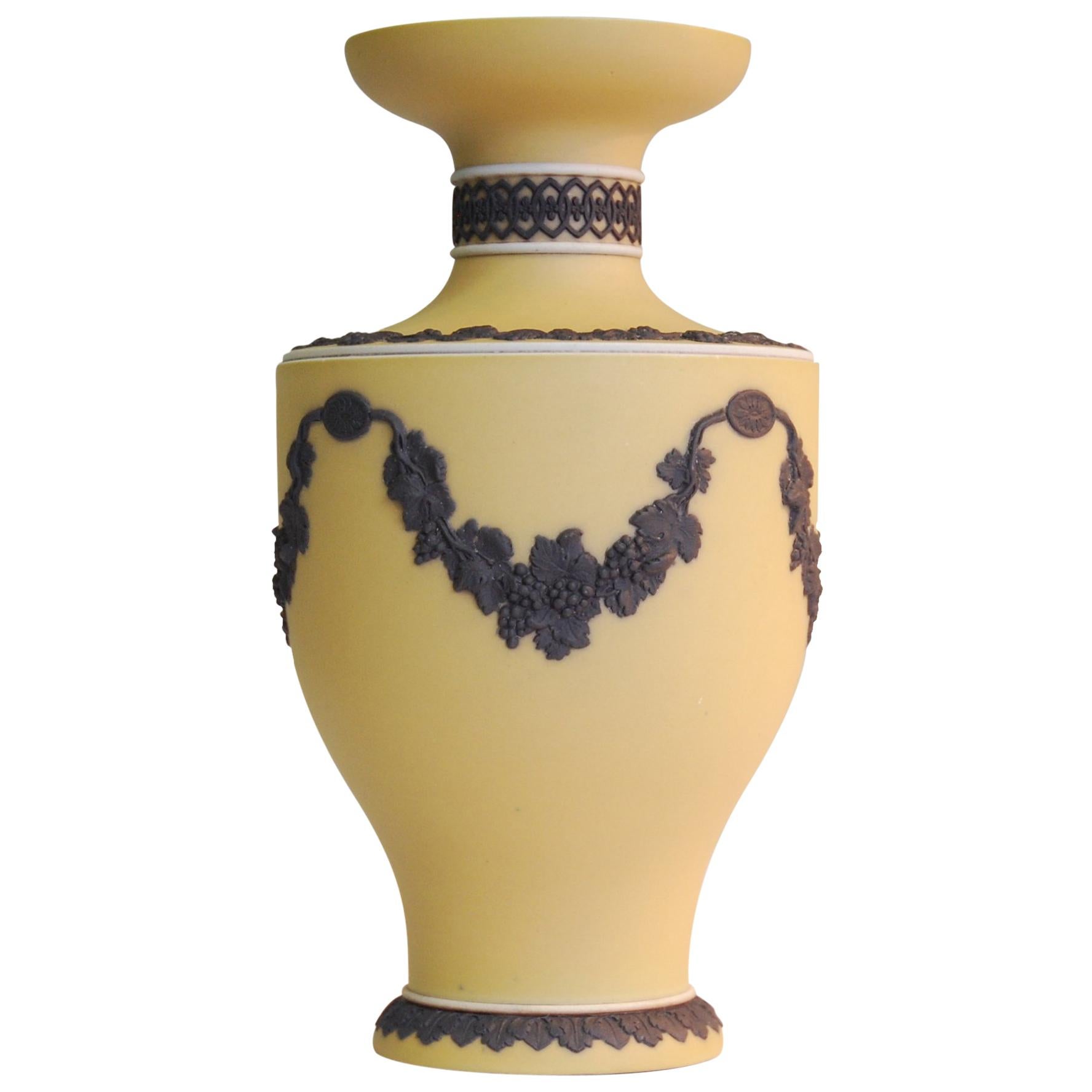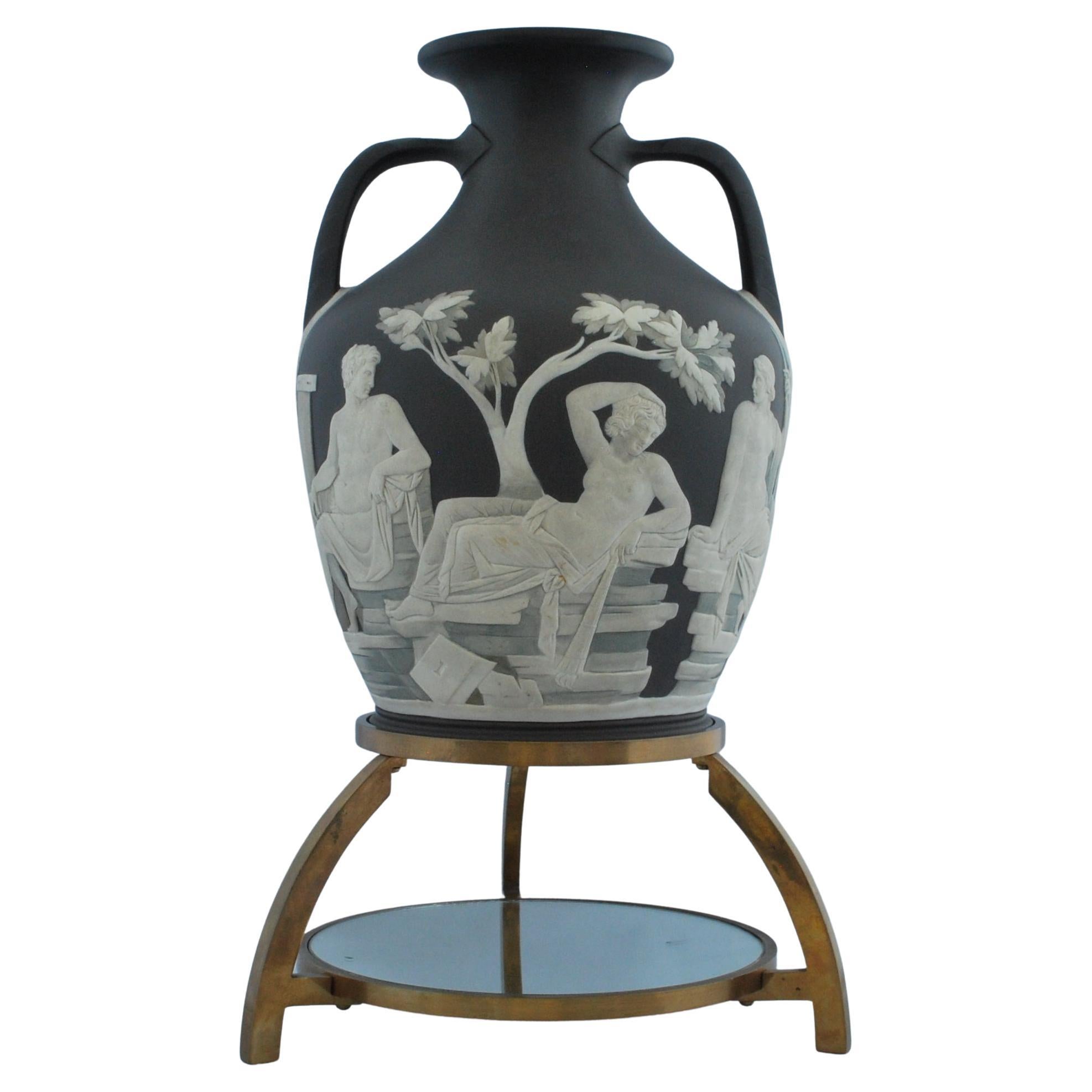Tea Canister, Crimson Jasper, Wedgwood, circa 1920
About the Item
- Creator:Wedgwood (Manufacturer)
- Dimensions:Height: 5.5 in (13.97 cm)Diameter: 3 in (7.62 cm)
- Style:Neoclassical (In the Style Of)
- Materials and Techniques:Stoneware,Turned
- Place of Origin:
- Period:
- Date of Manufacture:circa 1920
- Condition:
- Seller Location:Melbourne, AU
- Reference Number:
Wedgwood
Arguably the most celebrated of all English ceramics makers, Wedgwood was founded in 1759 by potter Josiah Wedgwood (1730–95) in Staffordshire, which was home at one time to hundreds of pottery workshops. The company is famed for its Jasperware — molded neoclassical stoneware vases, plates and other pieces inspired by ancient cameo glass, featuring white figures, scenes and decorative elements set in relief on a matte-colored background. The best-known background hue is light blue, but Wedgwood’s iconic silhouettes also appear on green, lilac, yellow, black and even white grounds. Some antique Wedgwood dinnerware pieces and other items feature three or more colors.
The Wedgwood firm first came to prominence for its tableware, which quickly gained favor in aristocratic households throughout Britain and Europe. In 1765, Wedgwood was commissioned to create a cream-colored earthenware service for Queen Charlotte, consort of King George III. The queen was so thrilled with her new china that Wedgwood was given permission to call himself “Potter to Her Majesty,” and the decorative style became known as Queen’s Ware.
Not to be outdone, Catherine the Great of Russia commissioned her own set of Wedgwood china in 1773. Nearly 200 years later, the firm created a 1,200-piece service for the coronation of Queen Elizabeth II. In recent years, leading designers including Jasper Conran and Vera Wang have collaborated with Wedgwood — in the tradition of such distinguished 18th-century artists such as the painter George Stubbs and metalsmith Matthew Boulton.
From plates and other dinnerware to decorative items like urns, cachepots and candlesticks, Wedgwood designs lend a traditional air to Anglophile interiors. And even if you have to make your own tea, you may find it comforting to sip it from a delicate cup that was manufactured in the same Stoke-on-Trent kiln that produced Her Majesty’s tea service. Be sure to keep your pinky raised.
Find antique Wedgwood pottery on 1stDibs.
- ShippingRetrieving quote...Ships From: Melbourne, Australia
- Return PolicyA return for this item may be initiated within 14 days of delivery.
- Pair of Crimson Jasper Portland VasesBy WedgwoodLocated in Melbourne, VictoriaA pair of Portland Vases in crimson jasper dip. Both of them superb, without the usual losses or bleeding associated with this ill-fated colour. Crims...Category
Vintage 1920s English Neoclassical Revival Pottery
MaterialsStoneware
- Jasper Vase in Buff with Black Ornament, Wedgwood, circa 1870By WedgwoodLocated in Melbourne, VictoriaA rare shape, in the scarce buff jasper dip with black ornament. A striking and unusual combination of colours in jasperware.Category
Antique Late 19th Century English Neoclassical Revival Pottery
MaterialsStoneware
- Big Framed Jasper Medallion, Clio by Bert Bentley, Wedgwood, circa 1925By WedgwoodLocated in Melbourne, VictoriaUnusually large and fine example of the work of the well-known decorator Bert Bentley. Clio, the muse of History, is reproduced with the exceptional quality that has made his work so desirable. Clio is the Greek muse...Category
Early 20th Century English Neoclassical Revival Pottery
MaterialsStoneware
- Portland Vase, Northwood, Wedgwood, circa 1880By WedgwoodLocated in Melbourne, VictoriaOne of the finest copies of The Portland Vase that Wedgwood produced, in many ways rivalling the First Edition itself. Decorated by Thomas Lovatt, then cut, polished and shaded by John Northwood in his glass engraving studio. Although 30 copies were intended, the work was so exacting and arduous that in the end only thirteen were finished. The mirrored stand, which is included, is later and I think dates from the late 20th century. Of all the stands designed for the Portland Vase, this is the best I've seen. The original Portland vase, dating from around 200AD and made of cameo glass, is considered one of the most important examples of classical design and is noted for its intricate relief sculptures, which depict classical figures and scenes from Greek mythology - exactly what, though, we're not sure. The original Wedgwood Portland Vase...Category
Antique 1880s English Neoclassical Pottery
MaterialsPottery
- Encaustic Painted Ecuelle, Wedgwood, circa 1790By WedgwoodLocated in Melbourne, VictoriaIn black basalt, decorated with encaustic painting. An écuelle is a French word that refers to a shallow dish or bowl, typically made of metal or ceramic, and used for serving food. Écuelle is also the French word for a small, shallow saucer used for serving soup. In English, an écuelle might be referred to as a soup plate or a soup saucer...Category
Antique 1780s English Neoclassical Pottery
MaterialsStoneware
- Shield-Shaped Vase, Wedgwood, circa 1773By WedgwoodLocated in Melbourne, VictoriaA shield-shaped vase, decorated to resemble porphyry, and highlighted with gilding. Marked for Wedgwood & Bentley.Category
Antique Late 18th Century English Neoclassical Pottery
MaterialsStoneware
- Wedgwood Crimson Jasperware PitcherBy WedgwoodLocated in New Orleans, LAThis striking Wedgwood crimson dip bas-relief covered jug features an applied white jasper neoclassical decoration of grapevines bordering the rim. De...Category
20th Century English Neoclassical Pottery
MaterialsPottery
- Set 18 Wedgwood Creamware Dessert or Salad Dishes England, circa 1820By WedgwoodLocated in Katonah, NYMade in England in the early 19th century, circa 1815, these Wedgwood dessert or salad dishes are a beautiful and sophisticated set. The combination o...Category
Antique Early 19th Century English Neoclassical Dinner Plates
MaterialsCreamware
- Wedgwood Pearlware Fox Hunting Jug, circa 1810By WedgwoodLocated in Downingtown, PAWedgwood pearlware fox hunting jug, circa 1810. This ovoid jug has a cylindrical neck, a projecting lip, and a ribbed ear-shaped loop handle. Bat prin...Category
Antique Early 19th Century English Georgian Pitchers
MaterialsPearlware, Pottery
- Wedgwood Creamware Platter or Charger 18th Century Made in England Circa 1785By WedgwoodLocated in Katonah, NYThis Wedgwood creamware round platter or charger was made in 18th century England circa 1785. The border is decorated with a traditional neoclassical design of iron-red flower heads...Category
Antique Late 18th Century English Neoclassical Decorative Dishes and Vid...
MaterialsCreamware
- Earthenware Tea Canister with Pewter LidLocated in East Geelong, VICThis pottery tea canister is decorated with very detailed, and quite pronounced, applied sprigs of fruit, flowers, leaves and butterflies, and there is a slight iridescence to the glaze. It is capped with a screw on pewter lid...Category
Antique Early 18th Century Dutch Rustic Pottery
MaterialsEarthenware
- Set Dozen Wedgwood Creamware Dinner Dishes Made England 1904By WedgwoodLocated in Katonah, NYMade in 1904, the border design on this set of Wedgwood dinner dishes was inspired by designs in Josiah Wedgwood's mid-18th century First Pattern Book. The red berries and beige leaves on the vine combine perfectly with the creamy color of the creamware plate. The result is a subtle beauty. The underside of the dishes has an impressed mark for Wedgwood and "W G" for August 1904. Dimensions: diameter 9.25" x .75" height Condition: Excellent Price: $1120 Background of Early 20th Century Wedgwood: In the late 19th century, Wedgwood designs were mostly influenced by the Aesthetic and Arts and Crafts movements. In 1904 Wedgwood promoted John Goodwin...Category
Early 20th Century English Neoclassical Dinner Plates
MaterialsCreamware






